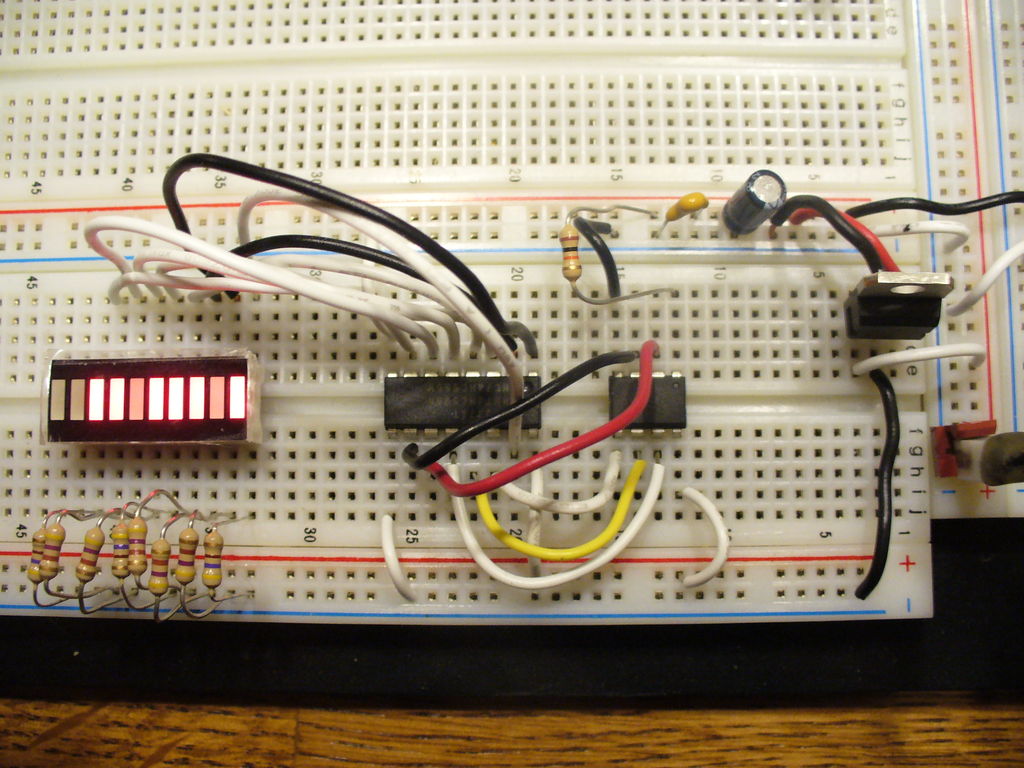Summary of How to use a 74HC595 Shift Register with a using AVR ATtiny13 microcontroller
This article introduces interfacing a 74HC595 8-bit serial-to-parallel shift register with an AVR ATtiny13 microcontroller to control LED patterns. It details the 74HC595 functionality, especially its latch feature, explains pin assignments, and guides setting up the circuit on a breadboard with LEDs, resistors, and necessary capacitors. The project demonstrates how to shift serial data into the register to control eight LEDs efficiently using minimal microcontroller pins.
Parts used in the 74HC595 and ATtiny13 LED Control Project:
- Breadboard
- 5V Power Source (7805 regulator or equivalent)
- ATtiny13 microcontroller
- Programmer (e.g., AVRISP mkII)
- 74HC595 Shift Register
- 100uF capacitor
- 0.1uF capacitor
- 10K resistor
- 8 LEDs
- 8 470 ohm resistors
- ~15 hookup wires
If you have been playing with microcontrollers and electronics then you have likely seen LED dot matrix displays and other projects that use shift registers like 7-segment displays and more. This instructable goes over a quick intro to the 74HC595 8-Bit Serail to Parallel Shift Register with Latch and how to interface it to an AVR ATtiny13 to flash some LEDs.
What you need:
1 – Breadboard
1 – Power Source – 7805 or some other 5v source
1 – ATtiny13 and a way to program it ( I’m using the AVRISP mkII with AVRStudio 4.17 w/ WinAVR)
1 – 74HC595 Shift Register
1 – 100uF cap
1 – 0.1uF cap
1 – 10K resistor
8 – LEDs
8 – 470ohm resistors
~15 – hookup wires
What is a Shift Register?
Serial to Parallel Shift Registers are ICs that allow “serial” data to be clocked in on 1 pin and stack up in a register which is output on 8 parallel pins (in the case of a 8-bit shift register). As data is clocked in, it shifts all the other bits over one position with the end one falling off. Common shift registers are 74HC164 and 74HC595.
There’s a couple of good online tutorials about these with animations.
www.eelab.usyd.edu.au/digital_tutorial/part2/register01.html
The 595 has another feature which is cool. It’s called a latch. It allows the outputs to show the current bits which have been latched in the Latch Register while new data is shifted into the Shift Register. Then toggle the latch pin and the new data is copied into the Latch Register.
Here’s a link to the 74HC595 Datasheet:
www.onsemi.com/pub_link/Collateral/MC74HC595A-D.PDF
Check Out a Youtube Video of the Circuit in Action
Step: 1 Get Familiar with the 595
The 74HC595 is a pretty cool little package. We are going to hook it up to shift in a pattern of leds
The pin out goes like this:
Pin 1 – Output B – source for LED (+)
Pin 2 – Output C – source for LED (+)
Pin 3 – Output D – source for LED (+)
Pin 4 – Output E – source for LED (+)
Pin 5 – Output F – source for LED (+)
Pin 6 – Output G – source for LED (+)
Pin 7 – Output H – source for LED (+)
Pin 8 – GND
Pin 9 – Serial Output – Carries Value from Output H to Data Pin (pin 14) of another 74HC595 to create a chain of SR’s.
Pin 10 – Shift Register RESET – Active LOW clears data in Shift Register, Latch Register is no affected.
Pin 11 – Shift Clock – LOW to HI transition shifts in data (0 or 1) from the Data Pin (pin 14). This can be toggled very fast in applications where you want a fast refresh rate like displays. I think you can toggle it on the order of 1000Hz +
Pin 12 – Latch Clock – LOW to HI transition latches the SR data to the outputs – The latch in our case will be triggered after every 8th bit is shifted in.
Pin 13 – Output Enable – Active LOW – Allows data in the Latch Register to show on the display. Typically this will be kept low, so you could just hard-wire it, but I have the AVR setup to control it.
Pin 14 – Serial Data In (Data Pin) – Don’t be scared by the word “serial”. It just means digital 1 or 0 on a single pin. This is where the AVR will feed in the bits
Pin 15 – Output A – source for LED (+) – It’s a weird spot for it but it works
Pin 16 – VCC 2.0-7.0 VDC
Step: 2 Hook it up on the breadboard
Setting up the Circuit is pretty simple. It will take you about 10 minutes.
Place the ATiny13 and the 74HC595 near each other.
Hook up VCC and GND on both.
Put the 10K resistor from the ATtiny13 RESET pin to VCC
Put the LEDs in a row with the 470ohm resistors on the LED cathodes to GND.
Run Hook up wires from the LED anodes to the 595 outputs in order A-H.
Here’s the important part:
Connect the ATtiny13 to the 74HC595 like this:
PB0 to Data Pin (pin14)
PB1 to Output Enable (pin13)
PB2 to Latch Clock (pin12)
PB3 to Shift Clock (pin11)
PB4 to Reset (pin10)
Also connect the Data Output (pin9) to GND since we aren’t using it.
Take alook at the provided schematic. It’s not beautiful but it will get the point across better than words.
The power supply shown in the schematic is pretty standard. You probably already have it setup. Just put the 100uF and 0.1uF caps across VCC to GND to smooth out any ripples.
Once you have it boarded up, hook up your programmer and go the the next step.
For more detail: How to use a 74HC595 Shift Register with a using AVR ATtiny13 microcontroller


